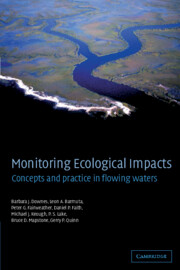Book contents
- Frontmatter
- Contents
- Preface and Acknowledgements
- Part I Introduction to the nature of monitoring problems and to rivers
- Part II Principles of inference and design
- Part III Applying principles of inference and design
- 8 Applying monitoring designs to flowing waters
- 9 Inferential uncertainty and multiple lines of evidence
- 10 Variables that are used for monitoring in flowing waters
- 11 Defining important changes
- 12 Decisions and trade-offs
- 13 Optimization
- 14 The special case of monitoring attempts at restoration
- 15 What's next?
- References
- Index
14 - The special case of monitoring attempts at restoration
Published online by Cambridge University Press: 21 August 2009
- Frontmatter
- Contents
- Preface and Acknowledgements
- Part I Introduction to the nature of monitoring problems and to rivers
- Part II Principles of inference and design
- Part III Applying principles of inference and design
- 8 Applying monitoring designs to flowing waters
- 9 Inferential uncertainty and multiple lines of evidence
- 10 Variables that are used for monitoring in flowing waters
- 11 Defining important changes
- 12 Decisions and trade-offs
- 13 Optimization
- 14 The special case of monitoring attempts at restoration
- 15 What's next?
- References
- Index
Summary
Not all assessments involve decisions about detecting an impact. Given that many substantial impacts have already occurred, there will be an increasing number (we hope) of programs geared towards assessing the success of restoration and rehabilitation programs. During the century ahead, we believe that an expanding response to human impacts on riverine ecosystems will be to attempt to restore them to some defined condition, such as a previous, less-impacted status. Such attempts to augment nature have considerable theoretical interest to ecologists as well as obvious practical implications for managers. It has often been said that the ultimate test of our understanding of an ecosystem is to create or repair a habitat and its function.
Ecological restoration is an applied approach to fixing environmental problems once they are diagnosed. It has arisen from a variety of practical starting points (Ehrenfeld 2000) and as such is not, as yet, a coherent and focused sub-discipline within scientific ecology. We see considerable confusion currently about the aims and techniques applicable to restoration monitoring (see also the critique by Chapman & Underwood 2000) but also appreciate the importance of going beyond merely detecting problems to trying to fix them.
We also do not wish to get entangled in subtle distinctions among ‘restoration’, ‘rehabilitation’, ‘regreening’ or ‘ecological landscaping’ (see Samways 2000) – if you are going to act then the outcome needs to be monitored. Our emphasis here is on being explicit about what you are trying to do regardless of the label you give it.
- Type
- Chapter
- Information
- Monitoring Ecological ImpactsConcepts and Practice in Flowing Waters, pp. 368 - 380Publisher: Cambridge University PressPrint publication year: 2002



